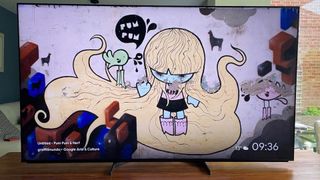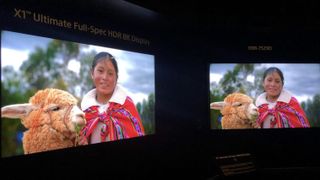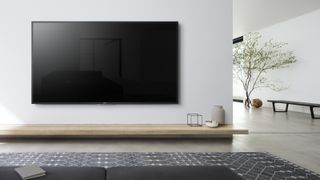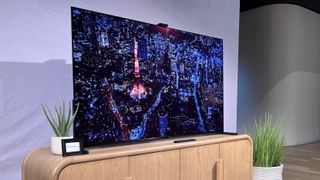Why Sony’s X95L TV shows a brand determined to swim against the tide
Watch this year’s series from this year’s top TV brands and listen to them discuss their plans for the future, and pretty much all you hear is ‘OLED this’ and ‘OLED that’.
LG has of course been all about OLED for a long time, while the OLED-promoting gap in performance and market position between the OLED and LCD TVs from Philips and especially Panasonic has deliberately widened in recent years.
TCL, once a veteran LED brand, is now enthusiastically talking about introducing printed OLED screens to its TV range in the near future, and perhaps most notably of all, even Samsung, traditionally the world’s largest OLED hold out’, this year by putting its QD-OLED TVs on at least equal footing with its once-beloved LED models, it has just signed a new panel supply deal with LG Display for regular WRGB OLED screens, and it’s sounding about overall very optimistic about the role of OLED in its future plans.
Just when you might think OLED’s dominance of the premium segment of the TV market was about to become complete, one major brand suddenly seems to have other ideas…
LCD TV technology still has a bright future
That brand is Sony, and in recent months it has shown clear signs that it may see LCD rather than OLED as the TV technology of the future.
The latest evidence of this came with my recent experience testing Sony’s second-generation mini-LED TV, the Sony X95L. This improved so much on what was actually a somewhat lackluster mini-LED debut range (2022’s X95Ks and X90K) that it not only confirmed that Sony engineers are clearly taking mini-LED very seriously, but also served as a powerful reminder to how much performance potential of mini LED TVs. Especially when it comes to brightness and color volume, and in combination with appropriate smart processing and advanced local dimming of the backlight.
My experience with the 65X95L came after press demonstrations by Sony, first in Japan last November 2023 and then again at CES 2024 in January in Las Vegas, of what the brand describes as a next-generation display technology built around LCD rather than OLED technology .
These demonstrations (of which you can find more details in this CES article) attempted to prove that an LCD panel combining mini-LED lighting with an advanced new local dimming system with new dimming control algorithms and a radically redesigned new power control infrastructure would significantly can deliver. more brightness than OLED screens in addition to OLED-like inky black levels. While they provide very little evidence of the ‘blooming’ effect of light, LCD TVs with local dimming systems usually produce roughly noticeable bright areas of the picture.
The LCD brightness goes beyond OLED
This new generation of LCD TV technology also proved to be able to operate more efficiently than OLED screens with most content – something that has become crucial in an era of increasingly strict TV power consumption regulations.
What really seems to be fanning the flames of Sony’s newfound enthusiasm for LCD over OLED technology, however, is LCD’s inherent brightness advantage.
Looking back at Sony’s TV history since high dynamic range video became a thing, there’s actually quite a bit of other evidence that the brand sees value in brightness levels beyond what organic displays are typically considered capable of.
No one who saw the 10,000-nit 8K prototype on Sony’s booth at CES 2018 is likely to have forgotten the experience. At the time, I thought that TV had the most spectacular picture quality I’d ever seen, and looking back on it now, the fact that it pushed so hard to reach the upper brightness limit of the forbidden HDR brightness range was a clear hint as to just how much value Sony places on brightness cuts.
This literally dazzling prototype was quickly supported with true ultra-bright consumer products in the form of 2019’s ZG9/Z9G 8K LCD TVs. These powered their massive pixel counts with by far the highest brightness levels – 4000 nits, no less – we’ve ever seen on a consumer had seen on TV.
Taking LCD out of the Middle Ages
We can trace Sony’s love of LCD and the HDR brightness it can deliver even further back than 2018’s CES with 2016’s classic ZD9 range, with their then groundbreaking ‘focused beam’ local dimming and local brightness enhancement technology.
Yet another sign of Sony’s love of light recently emerged in the professional division, in the form of a new BVM-HX3110 professional LCD mastering monitor that can deliver mastering-quality image management up to a peak brightness of 4000 nits. That’s four times brighter than Sony’s previous HX310 mastering monitor, and matches the maximum brightness of the old ‘Pulsar’ monitor that Dolby developed at the time to enable the full light expression of the Dolby Vision HDR format.
It can’t be a coincidence that Sony is developing a tool for content creators that can deliver so much of HDR’s potential brightness range and then almost simultaneously begins demonstrating a next generation of LCD-based TV technology aimed at delivering high brightness and contrast in addition to seemingly unprecedented LCD light control.
Both things together suggest that, as far as Sony is concerned, more brightness and lots of it is the future of display technology. And since that fits much better into LCD’s wheelhouse than OLED’s, that’s the direction the company is going.
A sign of things to come
None of this, of course, means that Sony believes the best OLED TVs use some sort of second-rate technology – or that the company is likely to ignore it in the future. In fact, the A95L Quantum Dot OLED range is currently being positioned as Sony’s most premium TV solution.
Sony has also long made it clear that it doesn’t believe in dictating to consumers what to buy, preferring instead to offer every technology somewhere in its range.
Nevertheless, signs past and present all point to Sony being determined to go in a different direction than most, if not all, of its major rivals. And if the recent demos of the new LCD prototype technology are anything to go by, I’m certainly very intrigued to see where we end up.




